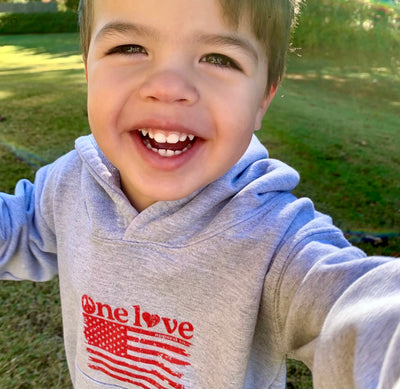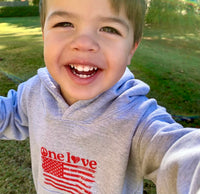Teaching Kids That Kindness Is Cool
Backpacks, New Shoes… and a Fresh Start

Back-to-school season comes with fresh notebooks, sharpened pencils, and maybe even a little nervous energy. It’s a reset button—a chance for kids to start new friendships, explore new classes, and redefine themselves. But it’s also a time when bullying and peer pressure can rear their heads.
At One Love Apparel, we believe kindness should never be seen as soft, boring, or uncool. Kindness is courage. Kindness is strength. And kids who learn that compassion is a power move—not a weakness—are the ones who make schools safer, healthier, and more inspiring.
So, how do we shift the culture? How do we teach kids that kindness is not just “nice,” but something to be proud of? Let’s dive in.
Why Kindness Needs a Rebrand
Kids are constantly told to “be nice.” But let’s be honest—that phrase can feel hollow. In a culture that sometimes rewards popularity, sarcasm, or toughness, kindness can get dismissed as something soft or optional.
The truth? Kindness takes guts. It means going against the crowd, speaking up when it’s easier to stay quiet, and treating others with dignity even when no one’s watching. That’s not weakness—that’s strength.
When we frame kindness as an act of courage, kids begin to see it as something to be admired. And that shift matters—especially in schools, where social dynamics can make or break a child’s confidence.
The Ripple Effect of Compassion
Teaching kids that kindness is cool isn’t just about stopping bullying—it’s about creating ripple effects that touch every part of a school community.
-
For kids who struggle: A single act of kindness can completely change a child’s day—or their life.
-
For classrooms: Compassion builds trust, making it easier for kids to learn and collaborate.
-
For teachers: Students who feel respected are more engaged, and classrooms run smoother.
-
For families: When kindness is valued at school, kids bring it home, influencing siblings and parents.
One kid holding the door, inviting someone to sit with them at lunch, or standing up for a peer doesn’t just help in that moment. It sends a message: this is what matters here.
How Parents Can Teach Kindness at Home
Kindness starts long before the school bell rings. Parents and caregivers play the first—and often most powerful—role in shaping how kids view compassion.
Lead by example. Kids are sponges. They notice how you treat the cashier, how you talk about neighbors, how you handle frustration. Show respect in your everyday actions, and they’ll absorb it.
Talk about feelings openly. Teaching emotional vocabulary—words like frustrated, nervous, left out—helps kids recognize emotions in themselves and others. This builds empathy.
Praise courage, not just compliance. Instead of only rewarding when kids “behave,” highlight when they go out of their way to be kind or include others.
Role-play tough situations. Practice what to do if they see someone being left out or teased. Having a plan makes them more likely to act with confidence.
How Teachers Can Build Kindness Into the Classroom
Classrooms set the stage for how kids interact with each other. Teachers can weave kindness into the fabric of their culture—not just as a rule, but as a value.
Normalize compassion. Celebrate acts of kindness the same way you’d celebrate academic achievement. Post a “kindness wall” where kids can shout out classmates for good deeds.
Create inclusive activities. Assign group projects intentionally, mixing kids who might not usually work together. It’s an opportunity to break cliques and form new bonds.
Address bullying directly. Instead of just saying “we don’t bully here,” give examples of what it looks like and what to do when it happens. Clarity matters.
Integrate kindness into lessons. Whether through literature, history, or current events, highlight stories of courage, empathy, and inclusion.
Equipping Kids to Be “Upstanders”
The opposite of a bully isn’t just the target—it’s the upstander. An upstander is someone who speaks out, steps in, or supports someone being mistreated.
We can teach kids that:
-
Silence is powerful, but not always helpful. Choosing to say something when others don’t is what makes kindness brave.
-
Small actions matter. Even inviting someone to sit with you at lunch can stop a cycle of exclusion.
-
They’re not alone. Encourage kids to team up—being kind is contagious, and standing together makes it easier.
The message is simple: don’t just stand by—stand up.
Digital Kindness: Extending It Online
Back-to-school season doesn’t just mean hallways and classrooms—it means social media, group chats, and online communities. Cyberbullying is real, and it often follows kids home.
Teaching digital kindness is just as important as teaching face-to-face compassion:
-
Think before posting. Is this helpful or harmful?
-
Don’t share gossip. Even if you didn’t start it, spreading it causes damage.
-
Show support online. A kind comment, a share, or even a DM can remind someone they’re not alone.
Digital spaces can either amplify cruelty or amplify kindness. Kids need to know they have the power to choose which one.
Breaking the “Cool” Myth
So why frame kindness as “cool”? Because kids live in a world where “cool” matters. If being cruel gets attention, kids learn cruelty has currency. The solution isn’t to lecture kids about why popularity doesn’t matter—it’s to redefine what “cool” looks like.
Cool isn’t who has the trendiest shoes or the sharpest comebacks. Cool is courage. Cool is compassion. Cool is including the new kid, speaking up, and knowing your words matter.
When kindness is seen as powerful—not passive—it reshapes how kids measure themselves and others.
Practical Back-to-School Kindness Habits
Want simple ways to help kids start the school year with kindness at the core? Try these:
-
Sit with someone new at lunch at least once a week.
-
Compliment classmates genuinely—on effort, not just looks.
-
Offer to help someone struggling, whether with homework or carrying supplies.
-
Thank teachers and staff regularly.
-
Start a kindness club or campaign in school—yes, kindness can be organized!
One Love Apparel: Why This Matters to Us
At One Love, kindness isn’t just a buzzword. It’s our mission. We create apparel that carries messages of love, compassion, and courage because we know that what you wear can start a conversation.
A shirt that says “You Are Not Alone” or “Be Kind Anyway” isn’t just fabric—it’s a reminder. A signal. A way to shift culture, one person at a time.
As kids head back to school, we want them to know that kindness is more than nice. It’s strong. It’s brave. And yes—it’s cool.
Conclusion: A Kinder Year Ahead
Back-to-school season is about more than supplies and schedules. It’s about shaping the culture kids will carry with them all year long.
When we teach kids that kindness is cool, we’re not just preventing bullying—we’re building leaders. Leaders who understand that compassion is powerful. Leaders who will create schools, workplaces, and communities where everyone belongs.
So this year, let’s remind kids—and ourselves—that kindness isn’t corny, cheesy, or weak. It’s courage. It’s connection. It’s what makes us human.
And in the halls of every school, that’s the kind of cool worth standing up for.



